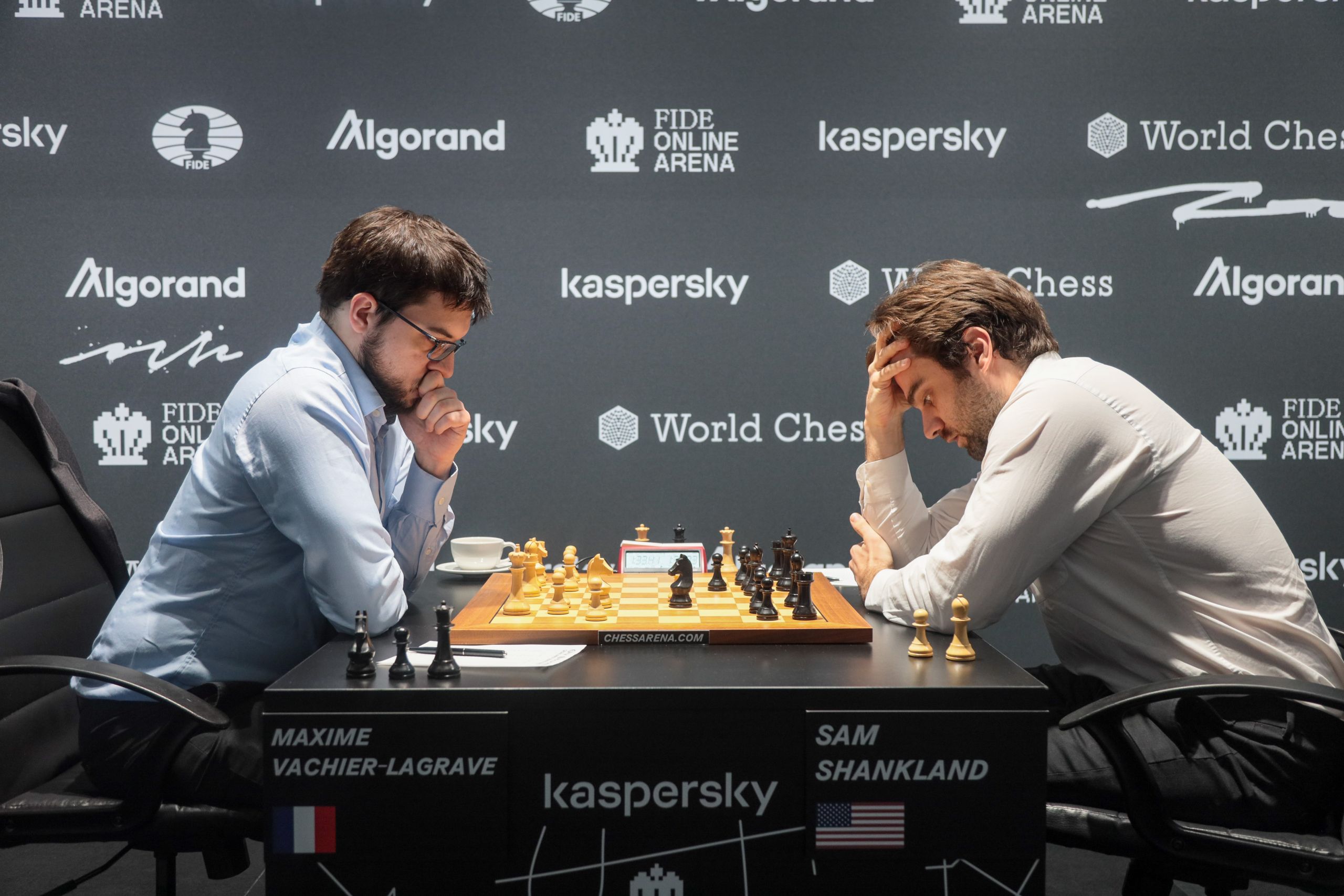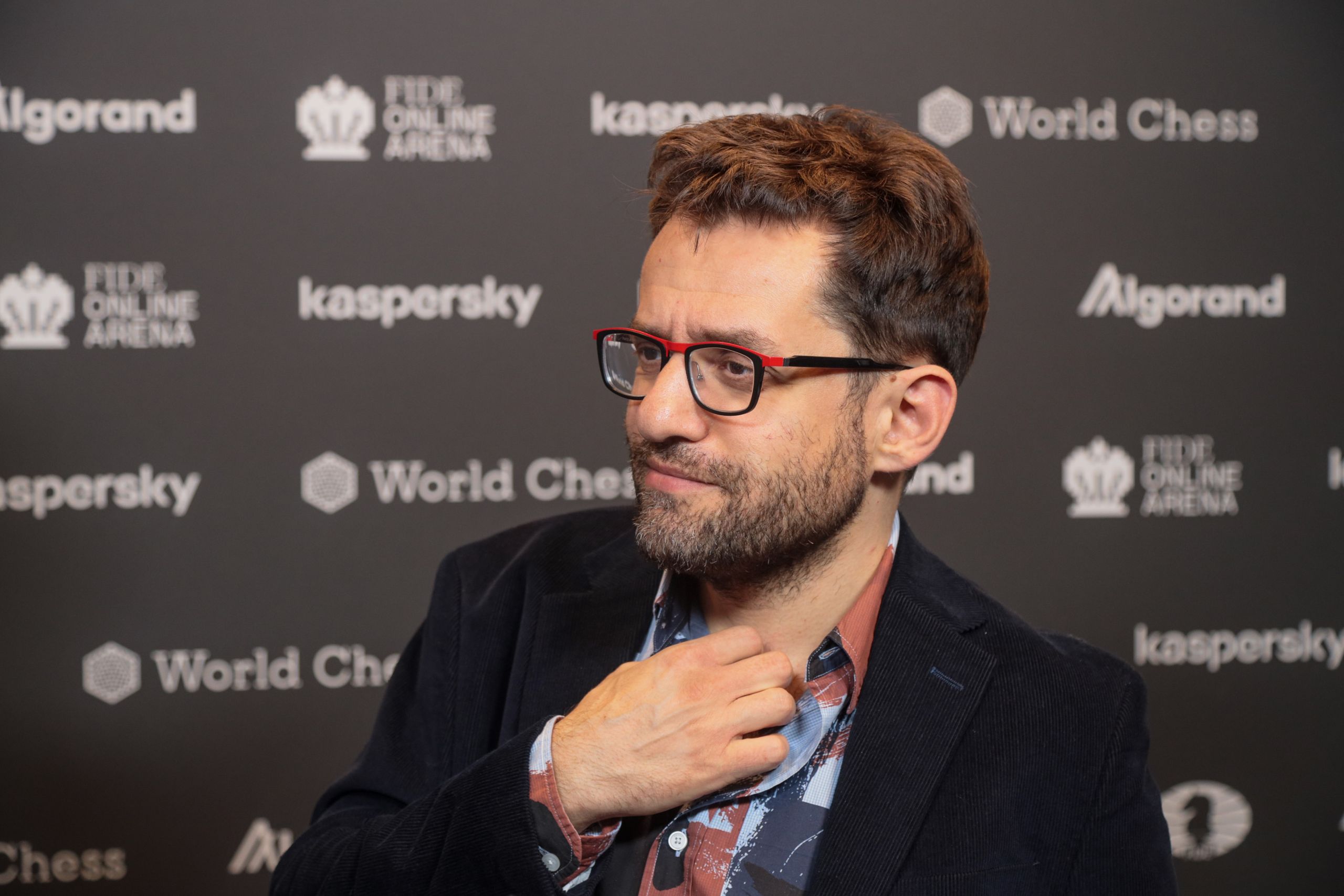FIDE Grand Prix Berlin – Round 2 Recap
It was a peaceful, but by no means uneventful day at FIDE Grand Prix Berlin although all eight games in Round 2 were drawn.
“Let’s talk about how dramatically the situation changed in every group after today’s round” joked the tournament commentator GM Evgeny Miroshnichenko and certainly, the standings have not changed at all as we have the same leaders as after Round 1 in each pool, namely Levon Aronian, Leinier Dominguez, Alexandr Predke, and Nikita Vitiugov. Round 2 results still don’t tell the entire story, as, despite peaceful outcomes, the games were hard-fought and enthralling.








Pool A
In the Giuoco Piano Levon Aronian, playing with White against Grigoriy Oparin, essayed the idea 12.Ra3, introduced by Nils Grandelius in the match against David Howell. After the game the American player added that he learnt from the best. He could not regret his choice as the game turned out to be very eventful. By lifting his rook White offered a pawn sacrifice, hoping to get some long-term initiative instead. Grigoriy spent a lot of time trying to remember his notes but eventually had to figure everything over the board.
“At that point, I had to take the pawn. With the whole concept of Black’s play, it doesn’t make any sense otherwise,” Oparin explained after the game. Aronian managed to regain the pawn in the ensuing complications, but he is not sure if 21.g4 was the best option. According to Levon, he could have played 21.Nc8 trading the knight for the bishop, followed by g3, which he thinks is more unpleasant for Black. On the other hand, it looks like after 21…g5, Black is OK. Grigoriy defended with precision, and the peace was signed right after the first time control.
Hikaru Nakamura obtained a promising position in Nimzo-Indian against Andrey Esipenko with a strong knight on e5. American Grandmaster played creatively in the opening, trying to get something interesting but then allowed the opponent to grab initiative by planting his knight on c4. “The game was basically around two squares e4 and e5. At some point, I just needed to trade the knights on c6 and make a draw, but I didn’t want to and just kept playing,” said Hikaru after the game. He called his plan with b4 and Na4 “insane” as after those moves, Black emerged clearly better, and for the rest of the game Andrey pressured Hikaru.
Being in a time trouble Andrey didn’t find a precise way to keep the tension, and after the massive exchanges, the game stirred into the ending with a visible edge for Black due to the pair of Bishops and better pawn structure. Nevertheless, it was hard to break through the position of White, and the American escaped with a draw thanks to the resilient defence.
Pool B:
The game Leinier Dominguez – Vincent Keymer saw a topical line of the Ruy Lopez in which the American introduced a novelty (the first line of Stockfish) on the move 14. After a tactical battle in the centre, Leinier won a pawn for which Black did not have sufficient compensation. After trading the queens, a very interesting ending with opposite-colour bishops and extra pawn for White appeared at the board. According to Leinier, he thought Black could not allow g6 move and had to take on g5 on 49th move. It seemed White had good winning chances, but the endgame requires a detailed analysis to make the final conclusions. To Vincent’s credit, he defended exceptionally well and saved a half-point in the game.
Daniil Dubov surprised Shakhriyar Mamedyarov with a rare on a top level 4.Nc3 in the Italian Game, but did not achieve much. Daniil pointed out that c5 was a strategically risky move for White as if White doesn’t manage to push d4, he can be worse. The Azerbaijani GM played solid, logical moves and got some play against the d3-pawn that outweighed White’s pressure in the center. The opponents started repeating the moves in a very complex balanced position in which draw seemed like a logical outcome.
“I think both sides could actually play in the final position, I don’t think I was better or worse; in general, it all felt very logical, and I think it was just a decent game. The reason why we repeated the moves is that if my opponent will play Nh7 when I don’t have d4 I’m much worse. That’s why I needed his rook to go away from d8,” explained Daniil after the game.
Pool C
Alexandr Predke, playing with White, managed to pose some serious problems for Wesley So in Giuoco Piano, which he called “very playable”. As the American confessed in a post-game interview, he missed the move 23.Ne3, which gave White a dangerous activity in the center. Alexandr thought that he had good winning chances, but it seems that Black’s position was not that bad, as Wesley reached a draw with several precise moves.
“This is the first time I play against Alexandr... He is a very good player; yesterday, he won a very good game against Maxime,” said Wesley at the post-game interview.
Maxime Vachier-Lagrave and Sam Shankland played the Berlin Defense, which is known as the Berlin Wall. Many great players have struggled to breach this solid barricade, and the French GM could not complete the task. Sam went for a strategically risky line, allowing White to play f5 as he was looking for a more dynamic fighting position. In a critical moment of the game Sam correctly sacrificed an exchange and got good compensation in the form of two pawns and active pieces. After trading a pair of rooks, none of the sides had winning chances and the game finished in a draw.
It turned out that both players had visited the Berlin Wall and surprisingly didn’t think about chess while walking next to it. Sam Shankland was actually thinking about his close relatives who lived in Germany many years ago. “My dad grew up in Germany, my grandparents are from the US; after WWII was over, my grandfather, a soldier, stayed around to try to rebuild Germany. So, my dad always told me that he could never cross the Wall because it was still around when he was growing up,” said Sam Shankland.
Pool D
Nikita Vitiugov didn’t expect Sicilian from Yu Yangyi, who normally chooses Petroff as in the previous game against Anish Giri. Nikita opted for a somewhat harmless line with Bb5 where White got a comfortable position. “I had some possibilities to play more actively but I was not able to find a proper way to create some problems”. The game ended in a draw after 22 moves.
Amin Tabatabaei and Anish Giri fought hard but did not manage to outplay each other. Anish Giri chose the only opening he has never played before – Chebanenko Slav. Amin thought he had checked all possible variations before the game, but Anish still managed to surprise him. “For the next time I’ll just take a rest and not prepare at all; in any case he will surprise me”, said Amin after the game with a smile.
Nevertheless, the Iranian GM managed to get a position with a small but clear edge after the queens left the board, and Anish had to work hard to maintain the balance. He came out with an interesting but provocative move e5. “I had a vision to play this move e5, and I missed everything, every single thing! I had to recalculate from the start while he started thinking, then I saw everything once it was not my move any longer. I think I missed Nb6 first, and I think I was worse after”, commented Giri on his critical decision. After half an hour of thinking, Amin took the pawn on e5 and was surprised by his own play later in the game as he turned his pleasant position into the worse one. However, he held it into a draw and yet it was another draw today, one which left Nikita Vitiugov in the lead of pool D.
Round 3 of the group stage will be played on Thursday, March 24, at 3 PM local (CET) time.
The pairings for the third round are as follows:
Pool A:
Grigoriy Oparin (FIDE), 2674 – Hikaru Nakamura, (USA), 2750
Andrey Esipenko (FIDE), 2723 – Levon Aronian (USA), 2785
Pool B:
Shakhriyar Mamedyarov (Azerbaijan), 2776 – Leinier Dominguez (USA), 2756
Vincent Keymer (Germany), 2655 – Daniil Dubov (FIDE), 2711
Pool C:
Sam Shankland (USA), 2704 – Alexandr Predke (FIDE), 2682
Wesley So (USA), 2778 – Maxime Vachier-Lagrave (France), 2761
Pool D:
Yu Yangyi (China), 2713 – Amin Tabatabaei (Iran), 2623
Anish Giri (Netherlands), 2771 – Nikita Vitiugov (FIDE), 2726
All Pairings please find here: Pool A; Pool B; Pool C; Pool D.
Leading partners supporting the FIDE Grand Prix Series 2022:
Kaspersky as the Official Cybersecurity Partner;
Algorand as the Official Blockchain Partner;
Prytek as the Technology Transfer Partner;
FIDE Online Arena as the official Partner.


